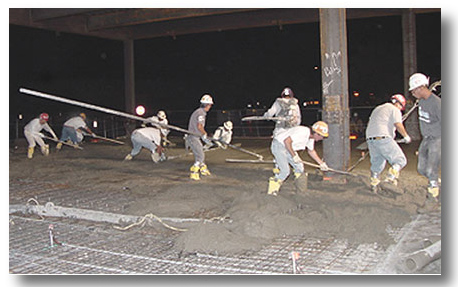Nothing sells better than previous work that was done correctly, on time, and that made the customer satisfied. Every contractor looks to increase their sales each year yet many continue to miss out on the easiest sell there is in the business…selling to a satisfied customer!
As a contractor, if you are having trouble getting repeat business with customers there is all likelihood that they may not have been as satisfied as you thought. The secret in repeat business isn’t selling what you’re “going to do” for the customer but what you have proven that you “can do.” Customers don’t buy bad memories.
have been as satisfied as you thought. The secret in repeat business isn’t selling what you’re “going to do” for the customer but what you have proven that you “can do.” Customers don’t buy bad memories.
So, let’s look at how you can get repeat business.
#1 Get it Right…the 1st Time
Most customers will not give a contractor a second chance; so you better get your first job with a new customer right the first time. This requires you to perform quality work in a quality manner. Remember, quality isn’t necessarily what you think it is but what your customer thinks. Therefore, it is very critical that you clearly understand what your customer’s needs and expectations are and do everything possible to conform to the customer’s definition of quality.
#2 Meet with Customer at Job Completion
I’m simply amazed how many contractors who are not even at the job when it is completed. They may be off getting another job started, measuring a parking lot to be sealed, or selling another new prospect. If you are an owner you should do everything possible to be at the job when it is actually completed. Rain or shine, problems or no problems, the senior person needs to be at the project to be able to make the first impression and sales effort toward the next project.
#3 Don’t Survey…Go Face to Face with the Customer
A good many contractors still attach a customer satisfaction survey with their final billing statement. This sales/marketing technique has been taught for many years, I ought to know as I’ve shared this same sales tip in many conferences. However, this effort isn’t good enough and, more importantly, rarely gets the results that was initially thought and taught. What’s the best action to take? Make it a personal visit with the customer, at the conclusion of their job, to walk the job site and discuss what they like and what they want to be improved, corrected, reworked. Going this extra step will gain you a personal audience with the customer and award you with lots of “brownie points” toward landing the next project with this customer.
#4 Inform the Customer that You Want Their Next Project
Think about this: you’ve just completed a project that the customer verbally confirms that they like what they experienced. This same customer tells you that they have another parking lot to pave or seal and stripe. You should, at that moment, not be shy about telling the customer of your interest in doing their next job. Have some fun with the customer by insisting that you want to extend their positive experience. Don’t be shy and just wait until the customer calls you later about that new work…because they just might not call!
#5 Maintain Follow-Up Points of Contact with Customers
This truly takes some discipline but it is really more of a scheduling issue than anything else. Set up a process in your scheduling for the year that allows you to be reminded of three to five follow-up contacts with each customer. The future contacts might include seasonal reminders to take care of their pavement, birthday cards, congratulations on the birth of a new child or a child’s graduation, or just dropping a note to say hi.[pullquote]The future contacts might include seasonal reminders to take care of their pavement, birthday cards, congratulations on the birth of a new child or a child’s graduation, or just dropping a note to say hi[/pullquote] If out of sight leads to out of mind then repeat follow-up will lead to repeat work.
#6 “Sell” Warranty on Your Completed Work
You may actually give a large portion of this away but selling your customers on allowing you to extend a warranty on your firms work will assist the effort to keep the customer leaning your way. Actually, you may find that it opens the door to more strategic planning and budgeting on your customer’s part to taking greater care of their pavement maintenance needs.
#7 Induce Repeat Customers with Discounted Pricing
Now before you think I’m just referring to lowering your prices for the sake of it, consider that you have little to know marketing costs associated with landing repeat business. In some cases you may not even be required to make another formal presentation but just amending the prior contract. This is worth something of a discount to the customer. Trust me, most customers do expect something in the form of a discount if they have worked with you before. And if you have completed more than one job for the same customer in the past I can almost guarantee you that the customer expects some kind of a discount.
#8 Work the Customer for Referrals
This effort is all consultant sales! If your customer is happy with you and your crew’s effort they will most likely be more than happy to give you the names of other friends and relatives that need your work. Don’t be shy about asking for such names. And don’t be shy about following up with your customer periodically over the next year to get additional names. Satisfied customers are never “put out” to help a hard working business person who is honest, does quality work, and is a pleasure to work with on top of everything else.
It has been my experience that many contractors often can build up to 40% – 60% of their annual revenues directly tied to repeat business. These same contractors never take such repeat business for granted as they expend a lot of energy to insure that they get every future project that their customers will be completing.
As you move to grow your company, don’t take any job lightly. Even if the job has gone badly, work hard to be visible and work diligently to solve the customer’s problems. Don’t avoid uncomfortable situations, especially if your crews have screwed up a job royally. It is often the “2nd shot” out of the rough that gets you and your company back in the middle of the fairway and set up for a great finish!


